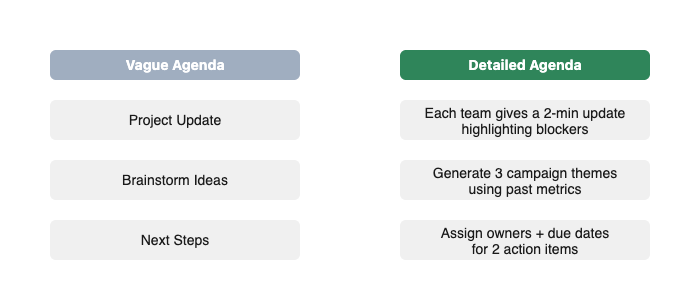Designing an effective agenda is one of the most important skills for running successful meetings. As highlighted by Roger Schwarz in the HBR Guide to Making Every Meeting Matter, most agendas are just vague lists of topics, which leads to confusion and wasted time. Research shows that a well-designed agenda is a strategic tool that:
- Sets clear expectations
- Helps everyone prepare
- Ensures meeting time is used productively
By turning your agenda into a detailed roadmap—with specific questions, preparation steps, and clear roles—you create meetings where everyone knows what’s expected and what needs to be accomplished.

An effective agenda sets clear expectations for what needs to occur before, during, and after your meeting. When team members know exactly what will be discussed, how to prepare, and what their role will be, they arrive ready to contribute rather than spending the first 20 minutes trying to figure out what's happening. This preparation transforms meetings from passive information-sharing sessions into active problem-solving collaborations.
Furthermore, your agenda should specify how members should prepare and who is responsible for leading each topic. For example, instead of listing "client feedback," write "Review the attached client feedback report and come prepared with three potential solutions." This ensures participants arrive ready for meaningful discussion. It also helps to assign a topic leader for each agenda item too to ensure accountability and prevents confusion about who should guide each part of the meeting.
Without this clarity, meetings often start with uncertainty: “What exactly are we discussing about the budget?” or “Are we making decisions today or just sharing information?” In contrast, a well-designed agenda allows the manager to open with confidence: “We’ll spend 20 minutes on the question: ‘How should we reallocate Q4 budget to address the Morrison account overrun?’ Shiv will lead this discussion, and everyone should have reviewed the pre-read.” This level of preparation transforms meetings into focused, productive sessions.
A fundamental principle is to seek input from team members when writing your agenda. This isn't just about being inclusive—it's about ensuring you're addressing the issues that actually matter to your team's success. Send a simple request asking "What topics do you need the team to discuss this week?" or "What decisions are blocking your progress?" This input prevents you from wasting precious meeting time on issues that could be handled elsewhere while missing critical topics that require group discussion.
When selecting topics, you must focus on those that affect the entire team and require their collective input. A common mistake is including items that only concern a subset of attendees, forcing others to sit through irrelevant discussions. If an issue only affects marketing and sales, don't make engineering sit through it in the all-hands meeting.
Reminder: Team meeting time is expensive. With eight people in a room, every hour represents a full day of individual work time. Therefore, use it only for genuinely interdependent issues where coordination is essential.
The most transformative element of this approach is listing agenda topics as questions the team needs to answer. Instead of vague topics like "platform migration," use a question such as "What are the three biggest risks to our platform migration, and how should we mitigate them?" This format clarifies the discussion’s goal, helps team members prepare specific answers, and signals when the topic is complete and when the question is answered. If someone goes off track, any team member can ask, "How does your comment relate to the question we're trying to answer?"
Here’s a condensed example of how a manager helps a team lead turn vague topics into actionable questions:
- Jessica: I’m struggling with tomorrow’s agenda. I’ve listed "customer complaints" and "team resources," but the last meeting with similar topics went nowhere.
- Victoria: Those are just topics. What do you actually need the team to answer?
- Jessica: For complaints, I need to know the root causes; for resources, whether to hire a contractor or redistribute work.
- Victoria: Great! Turn them into questions: "What are the root causes of our delivery complaints?" and "Should we hire a contractor or redistribute workload for Q4?"
Notice how Victoria helps Jessica transform vague phrases into specific questions that the team can actually answer.
For each agenda question, note the purpose: Are you sharing information, seeking input, or making a decision? A well-formatted agenda item might look like:
When you estimate a realistic amount of time for each topic, you're really estimating the complete cycle needed for quality discussion. This includes:
- Introducing the topic
- Allowing for clarifying questions
- Hearing different perspectives
- Working through disagreements
- Reaching resolution
Note that leaders typically underestimate because they forget to account for the natural back-and-forth of group discussion. If you think a decision will take 15 minutes, budget 25. It's far better to end early than to rush through critical decisions or table them until next time, which only creates frustration and delays progress.
The real power comes from proposing a process for each agenda item. Instead of just allocating 30 minutes to "How do we improve client onboarding?", break it down:
Sharing this time-boxed, step-by-step agenda in advance helps participants prepare and stay focused. Time estimates create productive pressure and keep discussions on track. While this structure may seem rigid, it actually frees everyone to engage fully, knowing exactly what’s expected and how the meeting will run. The result: meetings with clear outcomes and purposeful use of every minute.
You're now ready to put these agenda design principles into practice. In our upcoming real-world practices, you'll critique poorly designed agendas using this question-based format, create comprehensive agendas with time estimates and process steps, and practice the critical skill of opening meetings by reviewing and modifying the agenda as needed.
